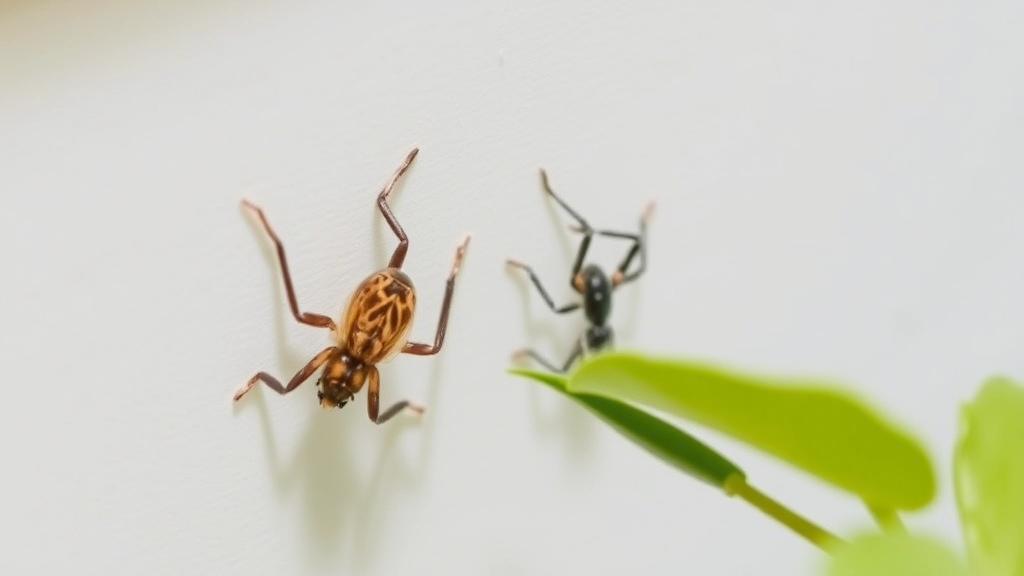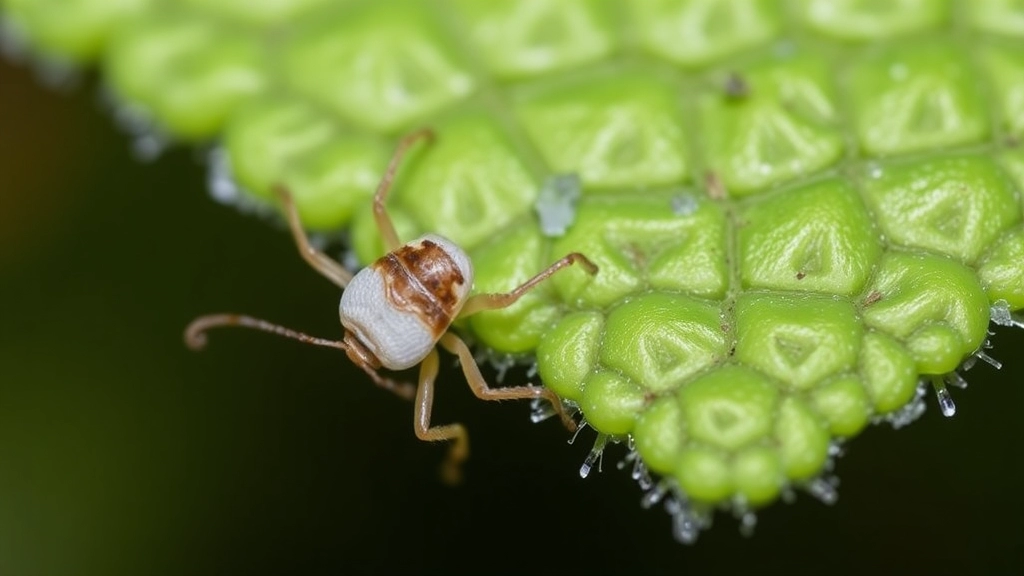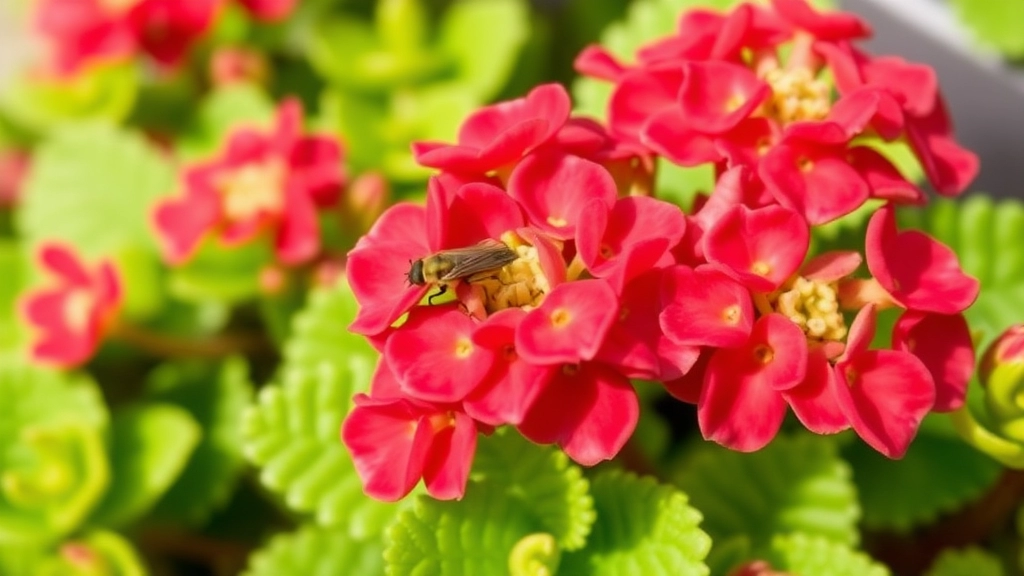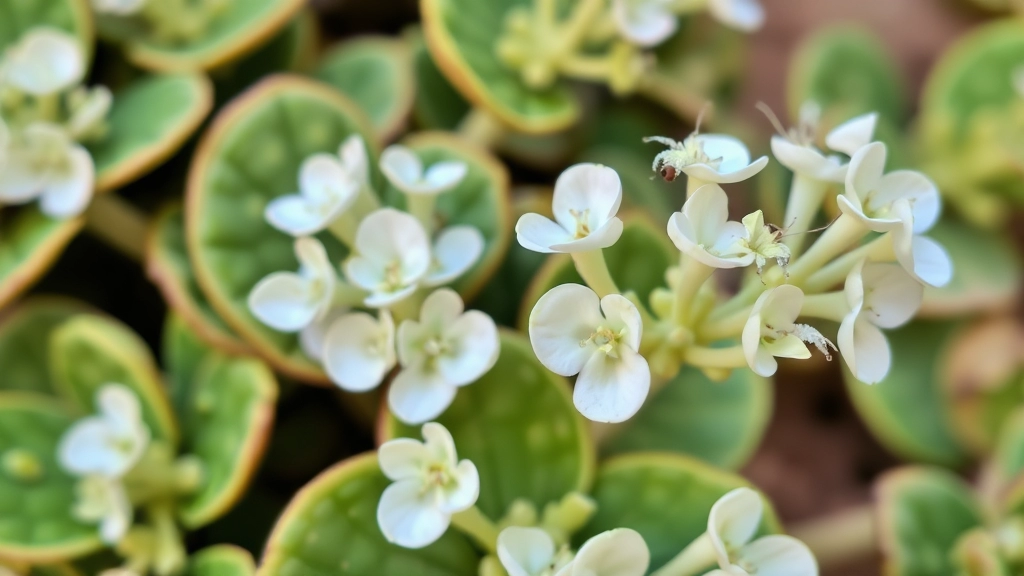Common Issues with Kalanchoe
Mealybugs
If you’ve noticed white bugs on your Kalanchoe, you’re likely dealing with mealybugs. These pests appear as white, cotton-like clusters on the undersides of leaves and stems, feeding on the plant’s sap. This can cause stunted growth, yellowing leaves, and even leaf drop if not addressed promptly.
Powdery Mildew
Another issue to watch out for is powdery mildew, a fungal infection that looks like white powdery spots on leaves and stems. While less common than mealybugs, powdery mildew thrives in the same warm, humid conditions that Kalanchoe plants prefer.
Treatment Options
Both problems need different treatments:
- Insecticidal soap or neem oil for mealybugs
- Potassium bicarbonate-based sprays for mildew
Identifying White Bugs on Kalanchoe
When you notice white spots on your Kalanchoe, it’s natural to feel concerned.
Are these pests?
Could it be something more serious?
Identifying white bugs on Kalanchoe is crucial for maintaining plant health.
The first step is to closely examine the leaves and stems.
Look for small, cotton-like masses or clusters.
These often indicate the presence of mealybugs, a common pest known for their white, waxy appearance.
Key Signs of Infestation:
- Cotton-like Clusters: Small, white, fluffy spots usually found in leaf axils or on stems.
- Sticky Residue: A sticky substance, known as honeydew, may be present, attracting other pests.
- Leaf Discolouration: Yellowing or wilting leaves can signal stress from pest activity.
- Webbing: In severe cases, you might notice fine webbing around the plant, indicating additional pest issues.
Identifying these signs early can prevent more significant damage. For more detailed care instructions, check out our expert tips on caring for Kalanchoe succulents. Additionally, if you’re looking to purchase new plants, consider our guide on buying flowering Kalanchoe plants online.
Common Pests That Cause White Buildup

So, you’ve spotted those pesky white spots on your Kalanchoe, and you’re probably wondering what’s going on.
It’s not just a random occurrence; it often points to some common pests that love to make your plant their home.
Let’s dive into the usual suspects:
- Mealybugs: These little critters are the most notorious for leaving a white, cottony residue. They latch onto your plant and suck out the sap, which can weaken it over time.
- Whiteflies: These tiny, moth-like insects can also create a white film on your leaves. They tend to hang out on the undersides of leaves and can be tricky to spot until it’s too late.
- Powdery Mildew: While not an insect, this fungal disease can mimic the appearance of pests. It shows up as a powdery white coating on leaves.
- Spider Mites: These are super tiny and often overlooked. They can create a fine webbing that gives a dusty look to your plant.
Understanding these pests is the first step in tackling the issue.
Mealybugs: The Most Frequent Culprit
When you spot those pesky white bugs on your Kalanchoe, mealybugs are often the primary suspect.
These small, cottony pests thrive in warm, humid environments, making your beloved plant their perfect home.
What Are Mealybugs?
- Mealybugs are soft-bodied insects that appear as small, white, fluffy masses.
- They feed on plant sap, weakening your Kalanchoe over time.
- Their presence can lead to stunted growth and leaf drop.
Why Are They So Common?
- They reproduce quickly, leading to rapid infestations.
- They can easily spread from plant to plant, especially in close quarters.
- Their waxy coating makes them resistant to some treatments.
Signs of Mealybug Infestation
- White, cotton-like clusters on leaves and stems.
- Sticky residue (honeydew) on the plant or surrounding surfaces.
- Sooty mould can develop on the honeydew, further harming your plant.
If you notice these signs, it’s essential to act quickly. For more detailed information on how to care for your Kalanchoe, check out our Ultimate Guide to Growing and Caring for Succulent Plant Kalanchoe. Additionally, if you are dealing with other issues like leaf discoloration, our guide on Why Kalanchoe Plant Leaves Turn Brown can provide helpful solutions.
Symptoms of a Mealybug Infestation

When you spot those pesky white bugs on your Kalanchoe, it’s crucial to understand the signs of a mealybug infestation.
What Should You Look For?
Mealybugs can be sneaky, often hiding in the nooks and crannies of your plant. Here are the symptoms you might notice:
- White Cotton-Like Clusters: These are the most obvious signs. They appear as small, fluffy spots on leaves and stems.
- Yellowing Leaves: If your Kalanchoe’s leaves are starting to turn yellow, it might be due to sap loss caused by these pests.
- Stunted Growth: A mealybug infestation can hinder your plant’s growth, making it look weak or underdeveloped.
- Sticky Residue: You may notice a sticky film on the leaves. This is honeydew, a byproduct of mealybug feeding.
- Black Sooty Mold: If left untreated, the honeydew can lead to the growth of sooty mold, which appears as a dark, powdery substance on the leaves.
- Wilting Leaves: In severe cases, you might see wilting or drooping leaves, indicating that the plant is under stress.
Recognising these symptoms early can save your Kalanchoe from serious damage.
Treating Mealybug Infestations Effectively
If you’ve identified mealybugs on your Kalanchoe, you might be feeling overwhelmed. The good news is that treating these pests can be straightforward. Here’s how to tackle a mealybug infestation head-on.
1. Manual Removal
Start by inspecting your plant closely.
- Use a cotton swab dipped in rubbing alcohol.
- Gently dab the mealybugs to kill them on contact.
- This method is effective for small infestations.
2. Insecticidal Soap
For larger infestations, consider using insecticidal soap.
- Spray the affected areas thoroughly.
- Ensure the soap covers the bugs directly.
- Follow the product instructions for dilution and frequency.
3. Neem Oil
Another effective treatment is neem oil.
- Mix neem oil with water as per the product guidelines.
- Spray it on the plant, focusing on the undersides of leaves.
- This not only kills mealybugs but also deters future infestations.
4. Systemic Insecticides
In severe cases, systemic insecticides may be necessary.
- These are absorbed by the plant and target pests that feed on it.
- Consult with a gardening expert for recommendations and usage.
5. Quarantine Affected Plants
If you have multiple plants, consider quarantining the infested Kalanchoe.
Preventing Pests on Kalanchoe

So, you’ve tackled those pesky mealybugs, but how do you ensure they don’t come back to haunt your Kalanchoe?
Let’s chat about some straightforward strategies to keep your plant healthy and pest-free.
1. Regular Inspections
- Keep an eye on your Kalanchoe.
- Check the leaves and stems for any signs of pests.
- Spotting an issue early can save you a lot of hassle later.
2. Quarantine New Plants
- If you’re bringing home a new plant, give it a little time away from your other greenery.
- This way, if it has any hidden pests, they won’t spread to your Kalanchoe.
3. Maintain Good Airflow
- Crowded plants can create a perfect environment for pests.
- Ensure your Kalanchoe has enough space around it for air to circulate.
- This helps prevent moisture buildup, which pests love.
4. Water Wisely
- Overwatering can stress your plant and attract pests.
- Make sure your Kalanchoe is in well-draining soil and only water when the top inch of soil feels dry.
5. Use Natural Predators
- Consider introducing beneficial insects like ladybugs or lacewings.
- They feast on pests and can keep your Kalanchoe safe without harsh chemicals.
6. Clean Leaves Regularly
- Dust can accumulate on leaves, making them more inviting to pests.
- Wipe down the leaves with a damp cloth every now and then to keep them clean.
7. Organic Sprays
- If you want an extra layer of protection, think about using neem oil or insecticidal soap.
- These natural options can deter pests without harming your plant.
After addressing the common issue of mealybugs, it’s essential to consider another potential problem: fungal infections.
Are those white powdery spots on your Kalanchoe actually a fungus?
Identifying the difference between pests and fungal infections can be tricky, but knowing what to look for can save your plant from further damage.
Key Indicators of Fungal Infections:
– **Appearance**: Unlike mealybugs, fungal infections typically present as a fine, powdery coating.
– **Location**: Fungi often appear on the leaves, stems, or soil, and may spread rapidly if not treated.
– **Texture**: The white spots may feel dusty or powdery to the touch, unlike the cottony texture of mealybugs.
Common Fungal Types to Watch For:
– **Powdery Mildew**: This is the most common fungal infection in houseplants. It thrives in humid conditions and can weaken your Kalanchoe.
– **Botrytis Blight**: Often seen in overly damp environments, this fungus can cause greyish-white spots and lead to wilting.
Treatment Options:
– **Remove Affected Areas**: Prune away any infected leaves or stems to prevent the spread.
– **Fungicide**: Apply a suitable fungicide, following the manufacturer’s instructions for best results.
– **Improve Air Circulation**: Ensure your plant has adequate airflow to reduce humidity levels, which can encourage fungal growth.
For more detailed information on how to prevent and treat these issues, you might find our guide on [Kalanchoe Leaf Spot: Causes, Treatment, and Prevention](https://planthq.org/kalanchoe-leaf-spot-causes-treatment-and-prevention/) helpful. Additionally, understanding the reasons behind leaf deterioration can be crucial, so check out our article on [Why Are My Kalanchoe Leaves Dying? Causes and Solutions](https://planthq.org/why-are-my-kalanchoe-leaves-dying-causes-solutions/).
Best Practices for Long-Term Plant Health
So, you’ve tackled those pesky white bugs, and now you’re wondering how to keep your Kalanchoe thriving for the long haul.
Let’s dive into some practical tips that’ll help you maintain a healthy plant and prevent future infestations.
FAQs About Kalanchoe White Bugs
What are the common pests that cause white buildup on Kalanchoe plants?
The usual suspects for white buildup on Kalanchoe plants include mealybugs, whiteflies, powdery mildew, and spider mites. Each of these pests or diseases can create a white film or residue on the plant.
How can I identify a mealybug infestation on my Kalanchoe?
Look for white cotton-like clusters on the leaves and stems, yellowing leaves, stunted growth, sticky residue (honeydew), black sooty mold, and wilting leaves. These are all indicators of a mealybug infestation.
What steps can I take to prevent pests on my Kalanchoe?
To prevent pests, you should:
- Perform regular inspections of your plant.
- Quarantine new plants before introducing them to your existing greenery.
- Maintain good airflow around your Kalanchoe.
- Water wisely to avoid overwatering and stressing the plant.
- Introduce natural predators like ladybugs or lacewings.
- Clean leaves regularly to remove dust and deter pests.
- Consider using organic sprays such as neem oil or insecticidal soap.
What are the signs that my Kalanchoe is stressed due to pests?
Signs of stress in your Kalanchoe due to pests include yellowing leaves, stunted growth, wilting leaves, and the presence of sticky residue or black sooty mold on the plant.
Can powdery mildew be mistaken for a pest infestation?
Yes, powdery mildew can mimic the appearance of pests. It shows up as a powdery white coating on leaves, which can be mistaken for pest residue.
How do I treat a mealybug infestation on my Kalanchoe?
Treat a mealybug infestation by wiping down the plant with a damp cloth, using insecticidal soap or neem oil, and introducing natural predators. Regular inspections and maintaining good plant hygiene can also help manage the infestation.
Why is it important to quarantine new plants?
Quarantining new plants helps to ensure that any hidden pests do not spread to your existing plants, including your Kalanchoe. This precautionary measure can save you from dealing with widespread infestations.
How does good airflow help in preventing pests?
Good airflow prevents moisture buildup around the plant, which pests love. Ensuring that your Kalanchoe has enough space for air to circulate can help keep pests at bay.
References
-
Kalanchoe Pests And Diseases: Learn About Common Kalanchoe Problems
-
Common Houseplant Pests: Types, Identification, and Control
-
Mealybugs: How to Identify and Get Rid of Mealybugs
